Legendary Canadian Veteran Richard Rohmer, 98, On His Unique Bond With Queen Elizabeth II

Legendary Canadian Veteran Richard Rohmer — seen here in Collingwood, Ont. in March of 2022 — dons his air force uniform along with 16 of his medals, including the Distinguished Flying Cross, which he won as a 20-year-old reconnaissance pilot serving with the Royal Canadian Air Force during the Second World War. Photo: Paul Alexander
Richard Rohmer has some weighty accomplishments. The events he’s seen and the things he’s done in his life have a genuine heft. That thought occurs to me as I help him into the blue tunic of his air force uniform for the photographer. At 98, one of the most decorated living Canadians is long past the military’s retirement age of 60, but he still has occasion to don his fancy rig as the Honorary Lieutenant-General of the Canadian Armed Forces. “Even though it’s ceremonial, it’s a role I cherish,” he says. “Not bad for an air force officer.”
He was granted that rank in 2015, while serving a three-year appointment as Honorary Adviser to the Chief of the Defence Staff, a role created specifically in recognition of Rohmer’s years of distinguished service, and the history he represents.
“With his background, his passion, he was the type of person needed to assist the Chief of the Defence Staff [the senior officer commanding all the Canadian Armed Forces] on matters involving all three services,” says Richard Mayne, the director and chief historian at Royal Canadian Air Force (RCAF) History and Heritage. “He’s exactly the type of person we’re proud of.”
The tunic is heavy — far heavier than you’d expect for what is essentially a four-button, wool suit jacket. The reason is the medals: I count 16 in a row on the tunic’s left breast, including the Distinguished Flying Cross, which he won as a 20-year-old reconnaissance pilot serving with the RCAF during the Second World War. It is followed by a slew of campaign stars and other medals from the war years through to the 1967 Centennial medal, which is trailed by various medals that mark the Queen’s Silver, Gold and Diamond Jubilees, the 125th anniversary of Confederation and the Canadian Forces’ Decoration. It builds to a big finish with the Légion d’honneur, awarded by the French government for his role in the liberation of France.
“I did some research on the Légion d’honneur,” he tells me as I fiddle with the Velcro bits on the ends of his sash. “I found out that Napoleon, when he created the decoration, also created the red sash. When I got the decoration, I went out and had the sash made. I’m the only one who wears a sash.”
He also typically wears the Order of Canada around his neck and dangles the Order of Military Merit and the Order of Ontario off the silver buttons on the front of his tunic. Incredibly, like an art gallery with an extensive collection, not all his medals are on display. When the late Prince Philip, himself a highly decorated veteran from his service in the Royal Navy in the Second World War, met Rohmer at the 60th anniversary of D-Day, he jokingly remarked, “You’ve got more medals than I have.”
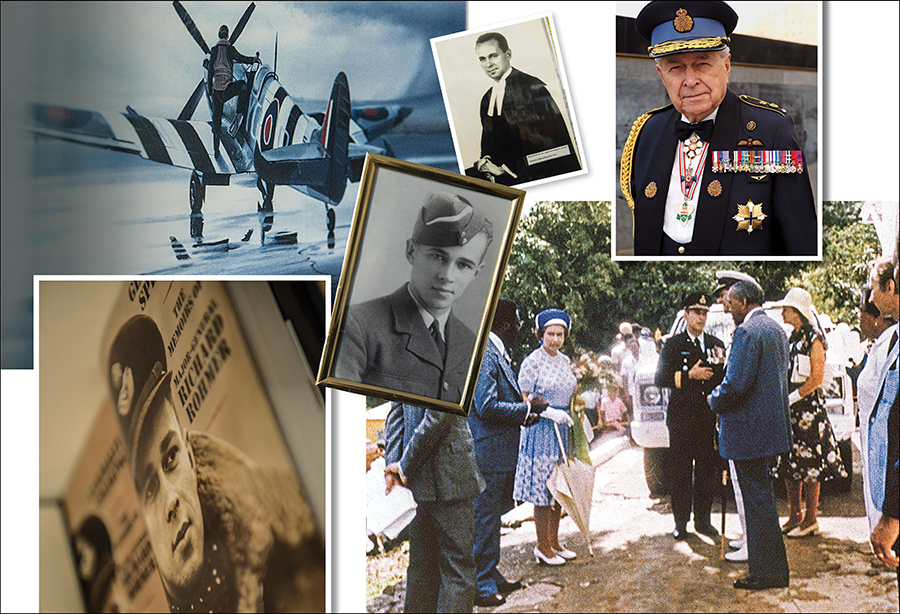
The Royals are one of the reasons we are visiting the condo in Collingwood, Ont., which Rohmer, a widower, shares with Charlie, a small fluffy white Yorkie-poo that his daughter, broadcaster Ann Rohmer, describes as resembling “half of a pair of bedroom slippers.” This past February was the Platinum Jubilee of Queen Elizabeth II — marking 70 years since her father died and she inherited the throne — and Rohmer has developed a real bond after meeting her several times. But there’s more to it than that. The Japanese have an intriguing term, Ningen Kohuhō, for “living national treasures,” which refer to those who embody the values and the history of its culture. Through her dedication to duty and her willingness to carry on, no matter what is happening around her (and to be honest, longevity helps), the Queen embodies this ideal for people in the U.K., Canada and around the world; so, in his way, does Rohmer, who represents patriotism and public service, with a big dollop of history mixed in. He’s also a pretty good example of how to age successfully.
The photographer has set Rohmer up in his office chair, where he is surrounded by an amazing selection of photos, commemorative scrolls and the sorts of things that a 12-year-old kid would be instantly drawn to: a model of the Mustang 1 fighter he flew during war operations, a miniature naval officer’s sword (he was in the naval reserves after the war), and an elaborate plinth from friends commemorating his role in knocking German Field-Marshal Erwin Rommel out of action and (very possibly) changing history. Flying a reconnaissance mission over France in the days after the Normandy invasion, Rohmer spotted a German staff car racing along a country road. Ordered not to engage enemy targets, he dutifully radioed in a report. A Spitfire shot up Rommel’s car, which crashed as a result. Rommel suffered a head injury that sidelined the Nazi officer during a key period in the battle for France.
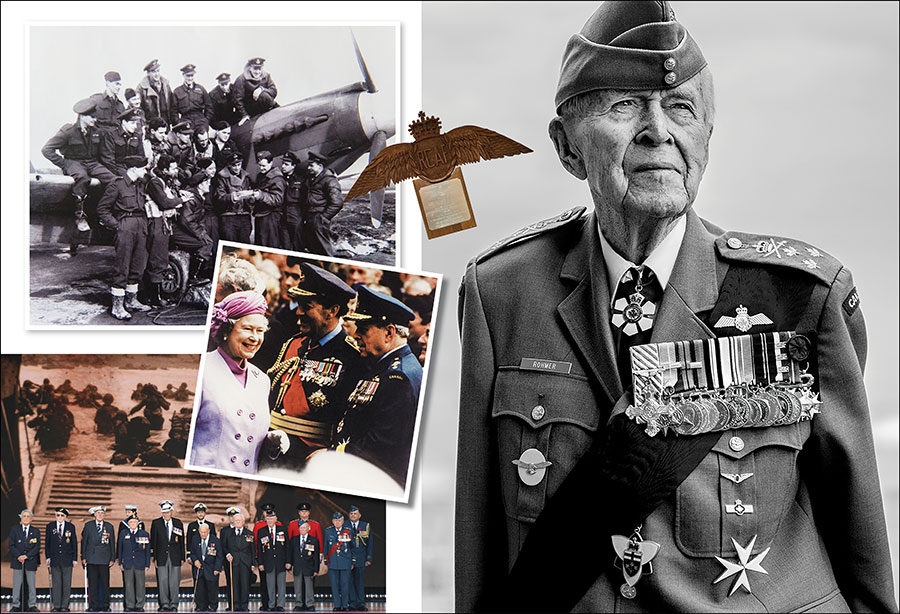
The doorbell seems to ring every few minutes, and Rohmer is off at a slow and steady pace, calling, “Don’t let Charlie out!” In the space of a few minutes, he welcomes the former mayor of Collingwood and the man who is fixing his mobility scooter. He no longer drives and only stopped flying about two years ago.
Rohmer has done a great deal over the years that would certainly earn him the adjective “distinguished” — his military service, right up to the rank of Major-General, commanding the reserves; his years as a corporate lawyer that stretch into this century; and his work for politicians like former Ontario premier John Robarts (1961-1971), whom Rohmer served as a special adviser. He even played a role in the creation of the McMichael Art Gallery in Kleinburg, Ont., and was instrumental in rezoning the land around the CN Tower, paving the way for its construction. But it’s the books on the shelves outside his office that made him genuinely famous, particularly the first four novels that he wrote back in the 1970s. (At last count, he’d written 32 books.)
He was partly inspired to write when he chaired a provincial royal commission on book publishing in 1971-72, and the first, Ultimatum, was published in 1973. “It was a success, and so I carried on,” he says. He resolved to write a book a year, and adopted a novel technique, in both senses of the word. “For my novels, I would dictate onto a small machine that I carried with me. When I was driving a car or I was someplace where I was flying, I could take the time to bark it into a machine and it seemed to work.” An understatement. Ultimatum was followed by Exxoneration (1974), Exodus UK (1975) and Separation (1976), which was later turned into a made-for-TV movie.
The ’70s gave birth to what we now call CanLit, a time when Margaret Atwood, Robertson Davies and Margaret Laurence were creating some of their most famous works. There was a hunger for Canadian stories, but not everyone wanted a sensitive tale about, say, coming of age in Coboconk, Ont. That’s where Rohmer came in. Canadian literary historian and author Brian Busby, one of the driving forces behind the website “Reading Richard Rohmer,” can still recall discovering his novels.
Busby didn’t get Canadian books in school, “so my introduction came through paperback racks. I remember as a kid buying the first four novels he wrote and gobbling them up. They were fun books.” Rohmer wrote fast-paced, political potboilers that were improbable, verging on the fantastical, at the time; in Ultimatum, the United States wants our oil, and will seemingly do anything to get it. This leads ultimately to war in Exxoneration, but it’s okay, because we outsmart them militarily and then buy Exxon. In Exodus UK, the Saudis reduce Britain to penury, so the British prime minister, looking for a way to shed citizens, wants to send two million to Canada. They fetch up here in Separation, which triggers a constitutional crisis with Quebec.
Critics hated the novels, with one calling Ultimatum, “a book only because it has printed pages between hard covers.” It didn’t matter, because Ultimatum was the No. 1 bestselling Canadian book in 1973, and Separation stayed on the Toronto Star’s bestseller list for 22 weeks. “They were very successful commercially, in a way that is very rare,” says Busby. “It was rare back then, it is rare now. He was a real bestseller.”
Rohmer has kept it up over the years, pumping out a succession of fiction and non-fiction on everything from the life of Canadian millionaire and racehorse breeder E.P. Taylor, to a novel featuring Sir John A. Macdonald, to his own memoirs. His subsequent books didn’t make the splash of his big four, but they had secured his position. “I still see Ultimatum at church rummage sales,” says Busby.
Rohmer clicks on the computer, and the photo he wants to show me slowly snakes out of his printer. He has two “workstations,” as he calls them — one in his office and one set up next to his open-plan kitchen, where you’d generally put the dining room table. It probably comes in handy when he is seized with inspiration or a sudden desire to Google something.
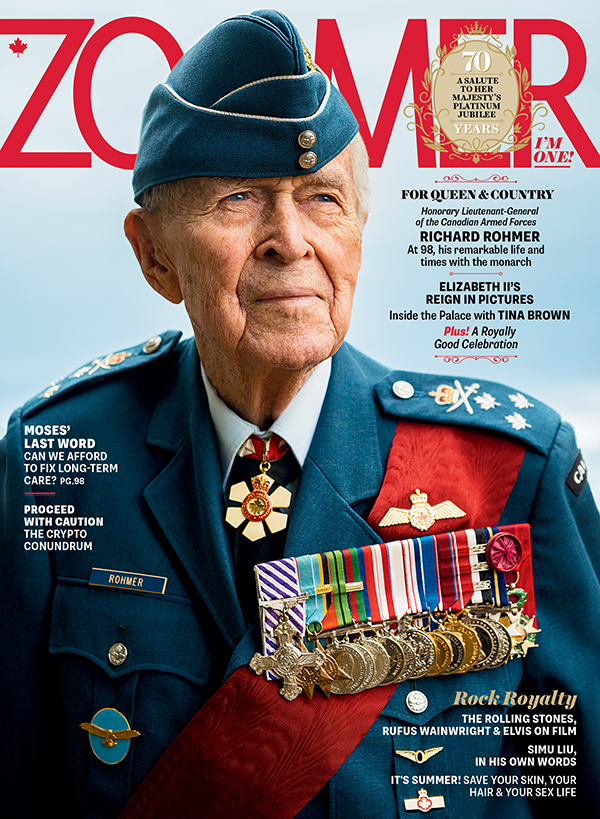
Rohmer has a great line: “When you get to be 98,” he says, “you know everybody.” His memoir, Generally Speaking, abounds with encounters with the great and famous, from American actress Rosemary Clooney to Sir William Stephenson, the legendary spymaster dubbed the “Man Called Intrepid.” He had his photo taken by American Canadian celebrity portraitist Yousuf Karsh, not once, but twice. Just pointing at something in his condo sparks a memory. “That is me with the chairman of the Joint Chiefs of Staff of the United States [Gen.] Mark Milley,” he says of a picture of his wall. “We met five years ago at a change of command parade in Ottawa, became instant pals.” To the right of it is a picture of the famed Red Baron, the First World War German flying ace Manfred von Richthofen, at age 25. Rohmer believes that an adjacent head-and-shoulders shot of him as a young RCAF pilot shows a strong resemblance to the legendary flyer. It does, but the real connection is as members of the fraternity of fighter pilots — a brotherhood that connects friend and foe alike. But if there is one person, outside his immediate circle of family and old friends, who holds a special place in his heart, it’s the Queen.
The picture he was printing off was one he’d recently rediscovered, showing him meeting the monarch for the first time in 1977 on Tortola, British Virgin Islands. He’d raised money through St. John Ambulance for a new emergency vehicle and flown it down there on a CAF Hercules to present the vehicle in the presence of the Queen. It wasn’t a flawless encounter. Rohmer wound up leading the Queen, her arms full of flowers, along a narrowing causeway three metres (10 feet) off the ground to take a look at the vehicle — because, as a former ambulance driver with the Auxiliary Territorial Service during the Second World War, she had expressed an interest in seeing it — only to find that someone had locked the door. As a result, the Queen never did inspect the vehicle.
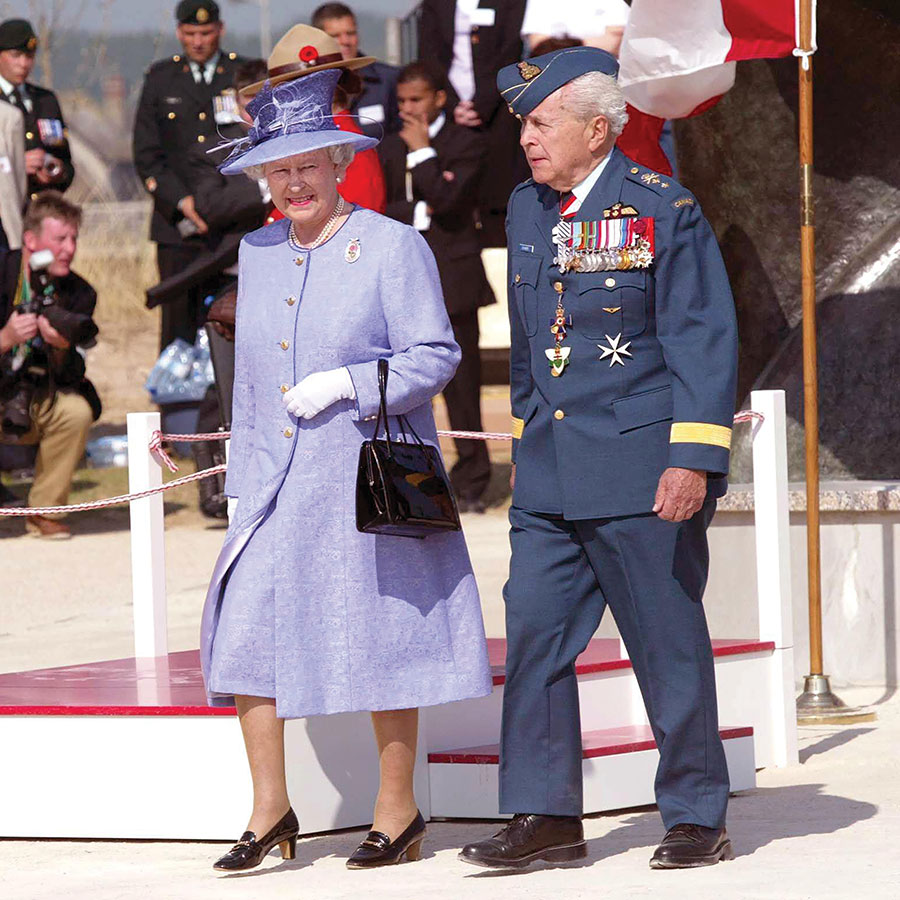
But from such modest beginnings, a personal connection was forged. Over the years, they have met repeatedly; their next encounter was at the dedication of the Canadian Memorial in London’s Green Park in 1994. Rohmer was the driving force behind her visit to Juno Beach in 2004 for the 60th commemoration of the D-Day landings, an operation that included 6,000 Allied veterans and their families, and featured both the Queen and her representative in Canada, then-Governor General Adrienne Clarkson. In 2007, at the 90th anniversary of Vimy Ridge, he was the first person the Queen spoke to after her speech. “I can still see her marching down with the prince, way up the hill, and I was down at the fence,” he says. “So that was very nice.” In 2010, they met again for a small audience at Queen’s Park in Toronto. “There was an immediate recognition on her part of him,” says Ann, who was there with her mother, Mary (or Mary-O, as she was always known), who died in 2020. “It was lovely to see that connection. She has a special twinkle in her eye when she admires someone, and you could see that very clearly when she spoke to my father.”
In 2019, he stood on stage before the Queen for the 75th anniversary of D-Day in Portsmouth, England. The oldest of 25 survivors of “the Longest Day,” he was the only one in military uniform, as the Honourary Lieutenant-General of the Canadian Armed Forces. When the Queen gave her televised Christmas speech on the BBC that year, Rohmer was front and centre, in a video clip from the ceremony that rolled as she recounted the event.
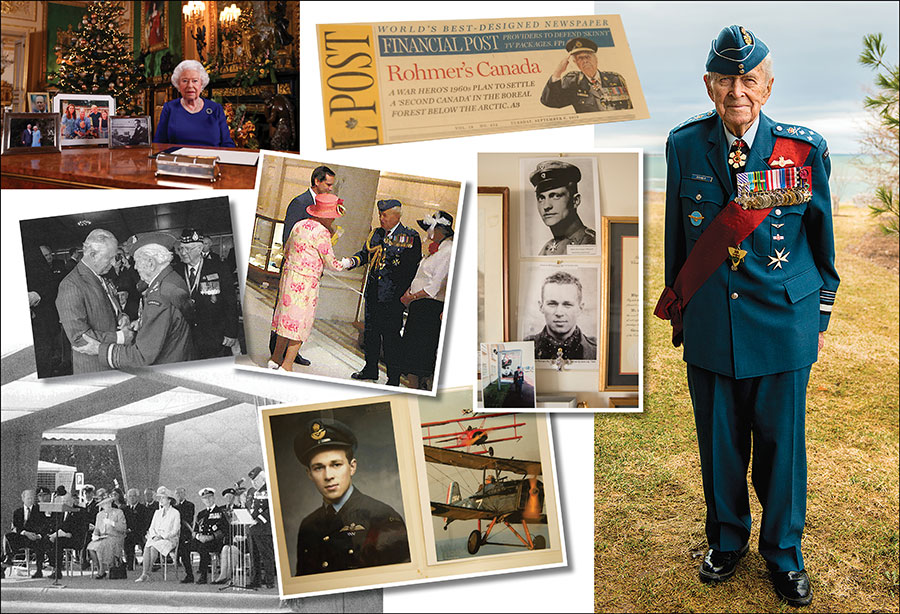
I wondered if there was a chivalric element to Rohmer’s attachment to the Queen. Here, after all, was a man who had sworn to be loyal to the sovereign when he joined the air force, so I ask if he sees himself as an unofficial knight pledged to his sovereign? But no. “I don’t feel that kind of serving thing.”
“This Queen is quite remarkable in all aspects,” he says. “She is forthright, easy to talk with, just a superb woman.” When he met her the first time in Tortola, “she was really in command.”
“I think, the way she has carried herself personally, with warmth and understanding, with great intelligence, doing the job she had to do, she has been a remarkable example for all of us in the Commonwealth in terms of how to live one’s life.” It’s probably fair to say that’s how Rohmer has tried to conduct himself, and what compels him to put on the general’s uniform and stand stiffly at attention. “As a highly decorated veteran himself and the honorary Lieutenant-General to the Canadian Armed Forces, Mr. Rohmer represents all that Canada has to offer to a larger global community,” says Mayne. At the meeting between the Queen and Rohmer in 2010, Ann recalls: “You see these two incredible human beings, similar in age; and their passion for their people and their country and the Commonwealth was apparent. It was just a moment.”
Rohmer doesn’t see Canada shedding the Monarchy any time soon. And from what he’s learned first-hand about Prince Charles since they met in 1978, Rohmer is confident in the prince’s ability to take his mother’s place when the time comes. He spoke with Charles extensively at the D-Day 75th anniversary celebrations and says, “I don’t think there’ll be any problem at all.”
When we talked in late March, Rohmer was busy trying to organize a celebratory parade to mark the Queen’s Platinum Jubilee. One thing’s for sure, he’s certainly not standing still. While Busby notes one of the trademarks of Rohmer’s novels is their settings in the near future, his daughter Ann uses an analogy to explain her father’s perspective. “I call it the windshield of life. He’s always looking through the windshield as opposed to the rear-view mirror.” As we wind down the interview, Rohmer hands me the dazzling, fiery abstract cover design for the non-fiction book he is working on, about high air temperatures in the Rockies and melting permafrost. Talk turns to recent events in Ukraine and what it means for us. “Canadians can’t get it through their heads that Russia is our northern boundary.
As a former pilot, he has an idea to defend our sovereignty. “The Americans are replacing an aircraft called the Harrier, which is a vertical take-off and landing fighter,” he says. “So all of those aircraft are going to be surplus, and what I want to do is to buy 100 of those used fighters for a dollar each and use them in our North. They don’t need runways. You can put six of them in a pod and they will look after everything … from an air defence point of view.” He’s drawn up a plan and hopes to send it to every Member of Parliament. And because it’s going to MPs, “I don’t even have to put a stamp on it.”
As he says, with a little smile, “I’ve got one or two things going on.”
A version this article appeared in the June/July 2022 issue with the headline “A General Fit For a Queen,” p. 38
RELATED:
Celebrating Queen Elizabeth’s Platinum Jubilee Celebrations in Canada
I Was There: Canadian D-Day Veterans Recount the Triumph and Terror on Juno Beach
Lest We Forget: Each Year, Three Canadian Medics Who Served in Afghanistan Take Stock of Their War